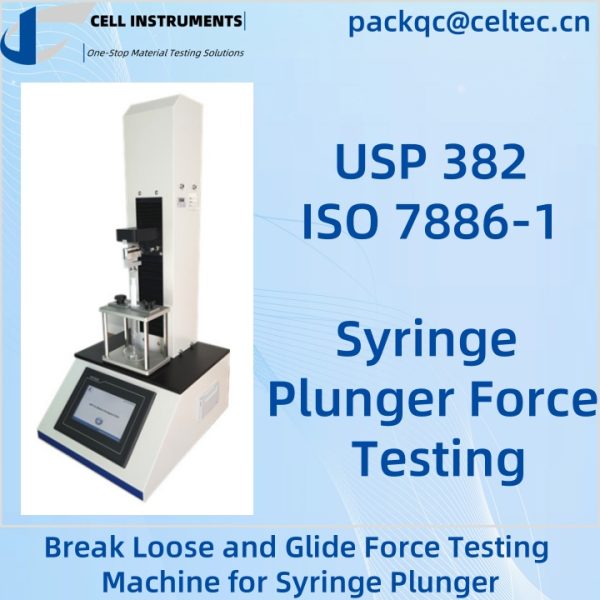ဖြုန်းတီးခြင်းနှင့် လျှောချခြင်းအား တွန်းအားပေးစမ်းသပ်ခြင်း။
—— USP 382 နှင့် ISO 7886-1
Break Loose နှင့် Glide Force Test ၏ အရေးပါမှု
ဖြိုခွဲခြင်းနှင့် လျှောလျှောတွန်းအားစမ်းသပ်ခြင်းသည် ထုပ်ပိုးခြင်းနှင့် ဆေးဘက်ဆိုင်ရာကိရိယာများ အထူးသဖြင့် ဆေးထိုးအပ်များတွင် အရည်အသွေးထိန်းချုပ်မှုတွင် အရေးကြီးသောလုပ်ငန်းစဉ်တစ်ခုဖြစ်သည်။ ဤစမ်းသပ်မှုသည် ရွေ့လျားမှုစတင်ရန် လိုအပ်သောအင်အား (break loose force) နှင့် ရွေ့လျားမှု (glide force) ကို တိုင်းတာသည်။ ဤစစ်ဆေးမှုများ၏ အရေးပါမှုမှာ တိကျမှု မရှိမဖြစ်လိုအပ်သော အထူးသဖြင့် ဆေးဝါးနှင့် ဆေးဘက်ဆိုင်ရာ အသုံးချမှုများတွင် ချောမွေ့သော လည်ပတ်မှု၊ ဘေးကင်းမှုနှင့် စွမ်းဆောင်ရည်ကို သေချာစေရန်အတွက် ၎င်းတို့၏ အခန်းကဏ္ဍတွင် ရှိနေပါသည်။
break loose နှင့် glide force များအတွက် စမ်းသပ်ခြင်း သည် ဆေးထိုးအပ်များသည် အခြေအနေအမျိုးမျိုးတွင် တသမတ်တည်း လုပ်ဆောင်ကြောင်း အာမခံပါသည်။ စက်မှုလုပ်ငန်းစံနှုန်းကို လိုက်နာခြင်းဖြင့်၊ USP 382ထုတ်လုပ်သူများသည် ၎င်းတို့၏ ထုတ်ကုန်များကို ဆေးဘက်ဆိုင်ရာနှင့် ဆေးဝါးဆိုင်ရာ အသုံးချမှုများတွင် အသုံးပြုရန်အတွက် လိုအပ်သော သတ်မှတ်ချက်များ ပြည့်မီကြောင်း သေချာစေနိုင်သည်။
Break Loose Force နှင့် Glide Force
နှစ်ခုလုံးသည် ဆေးထိုးပြွန်စွမ်းဆောင်ရည်အတွက် ကွဲပြားစွာသက်ရောက်မှုရှိသောကြောင့် break loose force နှင့် glide force အကြား ပိုင်းခြားရန် အရေးကြီးပါသည်။
- Break Loose Force: ပလပ်ဂါနှင့် စည်ကြားရှိ တံဆိပ်ကို ချိုးဖျက်ရန် ကနဦးအင်အား လိုအပ်သည်။ ဤတွန်းအားသည် ဆေးထိုးဆေးကို ပထမဆုံးအသုံးပြုသောအခါတွင် ယိုစိမ့်ခြင်း သို့မဟုတ် ချွတ်ယွင်းမှုမဖြစ်စေရန် သေချာစေသည်။
- အတင်းဝဲပျံ− ကနဦးပိုင်းပြတ်တောက်ပြီးနောက် ပလပ်ဂါရွေ့လျားနေစေရန် စဉ်ဆက်မပြတ်တွန်းအား လိုအပ်သည်။ ၎င်းသည် ဆေးထိုးအပ်သည် ရုတ်တရက် လှုပ်ရမ်းခြင်း သို့မဟုတ် တသမတ်တည်း စီးဆင်းခြင်းမရှိဘဲ ဆေးဝါးများကို ချောမွေ့စွာ ပို့ဆောင်ပေးကြောင်း သေချာစေသည်။
စွမ်းအားနှစ်ခုလုံးကို သီးခြားစီတိုင်းတာသော်လည်း ဆေးထိုးပြွန်၏ အလုံးစုံစွမ်းဆောင်ရည်ကို နားလည်ရန်အတွက် မရှိမဖြစ်လိုအပ်ပါသည်။ နှစ်ဖက်စလုံး၏ မှန်ကန်သော ချိန်ညှိခြင်းသည် ချောမွေ့ပြီး ယုံကြည်စိတ်ချရသော အသုံးပြုမှုကို အာမခံပါသည်။
Syringe Force Testing အတွက် စံနှုန်းများ
USP 382 နှင့် ISO 7886-1 ဆေးထိုးပြွန်အား စမ်းသပ်ခြင်းအတွက် လိုအပ်ချက်များကို ဖော်ပြသည့် အဓိကစံနှုန်းများဖြစ်သည်။ ဤစံနှုန်းများသည် ဆေးထိုးအပ်များသည် မြင့်မားသောစွမ်းဆောင်ရည်နှင့် ဘေးကင်းရေးစံနှုန်းများနှင့် ကိုက်ညီကြောင်း သေချာစေပါသည်။ USP 382 သည် ဆေးထိုးပြွန်များ၏ လုပ်ငန်းဆောင်တာလိုအပ်ချက်များကို အာရုံစိုက်ထားပြီး ISO 7886-1 နောက်ဆက်တွဲ E သည် တွန်းထိုးပလိန်းဂျားအားစမ်းသပ်မှုအပါအဝင် ဆေးထိုးပစ္စတင်လည်ပတ်ရန် လိုအပ်သောအင်အားများကို ဆုံးဖြတ်ရန်အတွက် စမ်းသပ်နည်းလမ်းများကို သတ်မှတ်ပေးပါသည်။
USP 382 syringe glide force စမ်းသပ်ခြင်း။
- ရည်ရွယ်ချက်- ဆေးထိုးအပ်၏ လုပ်ဆောင်နိုင်စွမ်းနှင့် ဘေးကင်းမှုကို သေချာပါစေ။
- ကန့်သတ်ချက်များ- ကနဦးအင်အား၊ အမြင့်ဆုံးအင်အား၊ တည်တံ့သောအင်အား။
- ထူးခြားချက်- လိုက်နာမှုသည် ဆေးဘက်ဆိုင်ရာဆက်တင်များတွင် ယုံကြည်စိတ်ချရသော ဆေးထိုးပြွန်စွမ်းဆောင်ရည်ကို အာမခံပါသည်။
ISO 7886-1 syringe glide force စမ်းသပ်ခြင်း။ နောက်ဆက်တွဲ E
- ရည်ရွယ်ချက်- ထိန်းချုပ်ထားသော အရှိန်ဖြင့် ဆေးထိုးဗူးမှတဆင့် ပလပ်ဂါကို ရွှေ့ရန် လိုအပ်သော အင်အားကို တိုင်းပါ။
- လုပ်ထုံးလုပ်နည်း- ဆေးထိုးဆေးကို စမ်းသပ်ကိရိယာတွင် ထားကာ ပလပ်ဂါကို ကြိုတင်သတ်မှတ်ထားသောနှုန်းဖြင့် ရွှေ့ပါ။
- ကန့်သတ်ချက်များ- ကနဦး၊ အမြင့်ဆုံးနှင့် တည်တံ့သော အင်အားများကို စံကန့်သတ်ချက်များနှင့် နှိုင်းယှဉ်တိုင်းတာသည်။
- ထူးခြားချက်- ဘေးကင်းရေးနှင့် လုပ်ဆောင်နိုင်စွမ်းအတွက် အရေးကြီးသော ဆေးထိုးအပ်များသည် အင်အားလိုအပ်ချက်များနှင့် ကိုက်ညီကြောင်း သေချာစေသည်။
Break Loose Glide Force ကို တိုင်းတာနည်း
- ဘိတ်: ဆေးထိုးတံအား စမ်းသပ်စက်တွင် လုံခြုံစေပြီး စမ်းသပ်မှုအတွက် ပလပ်ဂါကို နေရာချထားပါသည်။
- Break Loose Force Measurement− ပလပ်ဂျာ၏ တံ ဆိပ်ကို ချိုးဖျက်ရန် လိုအပ်သော ကနဦး အင်အားကို တိုင်းတာသည်။ ၎င်းကို "break loose force" သို့မဟုတ် plunger ၏လှုပ်ရှားမှုကိုစတင်ရန် လိုအပ်သောအင်အားဟု ခေါ်သည်။
- Glide Force တိုင်းတာခြင်း။− ပလပ်ဂါရွေ့လျားပြီးနောက်၊ စစ်ဆေးမှုသည် ချောမွေ့စွာရွေ့လျားရန် လိုအပ်သည့် စဉ်ဆက်မပြတ်အားကို တိုင်းတာသည်။ ၎င်းကို "လျှောလျှောတွန်းအား" ဟုခေါ်သည်။
- စမ်းသပ်မှုအခြေအနေများ: ရလဒ်များသည် လက်တွေ့ကမ္ဘာအသုံးပြုမှုကို ထင်ဟပ်ကြောင်းသေချာစေရန် အပူချိန်ကဲ့သို့ ထိန်းချုပ်ထားသော ပတ်ဝန်းကျင်အခြေအနေအောက်တွင် စမ်းသပ်မှုကို ပုံမှန်အားဖြင့် ပြုလုပ်ပါသည်။
Break Loose နှင့် Glide Force Test အတွက် စမ်းသပ်ကိရိယာ
Cell Instruments MST-01 Break Loose Glide Force Tester သည် ဆေးဘက်ဆိုင်ရာကိရိယာစမ်းသပ်ခြင်း၏ ပြင်းထန်သောလိုအပ်ချက်များကိုဖြည့်ဆည်းရန် ဒီဇိုင်းထုတ်ထားသည်။ ၎င်းသည် ဆေးဘက်ဆိုင်ရာနှင့် ဆေးဝါးဆိုင်ရာအသုံးချပရိုဂရမ်များတွင် လိုအပ်သည့် မြင့်မားသောစွမ်းဆောင်ရည်နှင့် ဘေးအန္တရာယ်ကင်းရှင်းမှုဆိုင်ရာ စံချိန်စံညွှန်းများနှင့် ကိုက်ညီကြောင်း သေချာစေကာ ဆေးထိုးအပ်၏ပလပ်ကိုတွန်းရန် လိုအပ်သောတွန်းအားကို တိကျစွာတိုင်းတာပေးပါသည်။
MST-01 ၏ နည်းပညာဆိုင်ရာ သတ်မှတ်ချက်များ
| စမ်းသပ်ကွင်း | 50N (သို့မဟုတ် လိုအပ်သလို) |
| လေဖြတ်ခြင်း။ | 200mm (ကုပ်မပါ) |
| စမ်းသပ်မြန်နှုန်း | 1 ~ 500 မီလီမီတာ / မိနစ် |
| နေရာရွှေ့ပြောင်းမှု တိကျမှု | 0.01mm |
| တိကျမှု | 0.5% FS |
| အထွက် | မျက်နှာပြင်၊ မိုက်ခရိုပရင်တာ၊ RS232(ချန်လှပ်ထားနိုင်သည်) |
| ပါဝါ | 110~220V |
အဓိကအင်္ဂါရပ်များနှင့် အကျိုးကျေးဇူးများ
- ယုံကြည်စိတ်ချရမှုနှင့် တိကျမှု- PLC ထိန်းချုပ်မှုဖြင့် မြင့်မားသောတိကျမှုနှင့် ယုံကြည်စိတ်ချရမှု။
- အသုံးပြုရလွယ်ကူမှု- ကျွမ်းကျင်မှုအဆင့်အားလုံးအတွက် အသုံးပြုရလွယ်ကူသော မျက်နှာပြင်။
- ကြာရှည်ခံမှု- အရည်အသွေးမြင့် ပစ္စည်းများဖြင့် တည်ဆောက်ထားပြီး ရေရှည်အသုံးပြုနိုင်ပါသည်။
- ဖောက်သည်ပံ့ပိုးမှု- တပ်ဆင်ခြင်း၊ လေ့ကျင့်သင်ကြားခြင်းနှင့် ပြုပြင်ထိန်းသိမ်းခြင်းများအတွက် ပြည့်စုံသောပံ့ပိုးမှု။
Break Loose နှင့် Glide Force Test ဆိုင်ရာ FAQs
A1- အားလျော့ရဲသောစမ်းသပ်ခြင်းအား ချိုးဖျက်ခြင်းဖြင့် စည်အတွင်းရှိ ဆေးထိုးပလပ်ဂါ၏ ရွေ့လျားမှုကို စတင်ရန် လိုအပ်သော အင်အားကို တိုင်းတာသည်။
A2- Glide force testing သည် ဆေးထိုးပြွန်အား အလွန်အကျွံအားမရှိဘဲ ချောမွေ့စွာ ရွေ့လျားနေကြောင်း သေချာစေသည်၊၊ တိကျပြီး ဘေးကင်းသော ဆေးဝါးများပေးပို့ရန်အတွက် အရေးကြီးပါသည်။
A3- MST-01 သည် ဆေးထိုးတံကို တွန်းထုတ်ရန် လိုအပ်သော အင်အားကို တိုင်းတာပြီး ဆေးထိုးပြွန်များ၏ စွမ်းဆောင်ရည် စံချိန်စံညွှန်းများနှင့် ကိုက်ညီကြောင်း သေချာစေရန် အချိန်နှင့်တပြေးညီ ဒေတာနှင့် ခွဲခြမ်းစိတ်ဖြာမှုများကို ပံ့ပိုးပေးပါသည်။
A4- USP 382 နှင့် ISO 7886-1 တို့သည် ဆေးထိုးအပ်ပလပ်ဂါအား စမ်းသပ်ခြင်းအတွက် လိုအပ်ချက်များကို ဖော်ပြသည့် အဓိကစံနှုန်းများဖြစ်သည်။
A5- ဟုတ်ကဲ့၊ Cell Instruments သည် မတူညီသော ဆေးထိုးအပ်အရွယ်အစားအတွက် စမ်းသပ်သူကို လိုက်လျောညီထွေဖြစ်အောင် စိတ်ကြိုက်ပြင်ဆင်မှု ရွေးချယ်မှုများကို ပေးဆောင်ပြီး အပိုလုပ်ဆောင်ချက်များကို ပေါင်းစပ်ပေးပါသည်။



